NANTWICH, HOLLY HOLY DAY
Grid Ref: SJ 652 523
25 January 2003, 21 January 2012 and 25 January 2014
Every year, on a Saturday in late January, the Battle of Nantwich
is celebrated with the aid of the 'Sealed Knot Society', which performs re-enactments
of battles of the English Civil War. In late January there is often insufficient
light for photograpy but here is a selection of pictures taken on two differerent occasions.
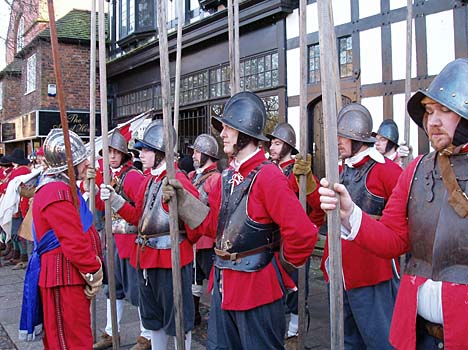 |
|
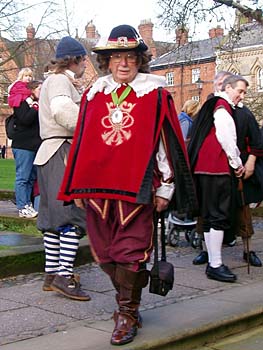 |
| Pikemen |
|
In front of the church |
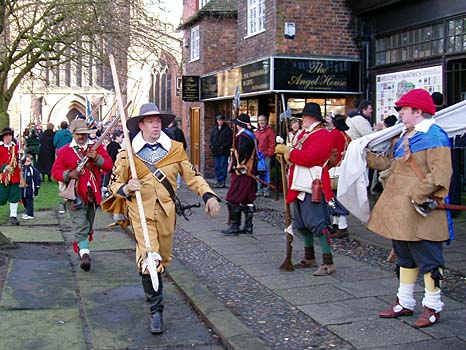 |
|
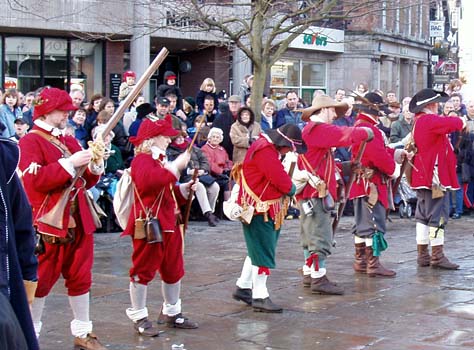 |
| Inspecting the troops |
|
Musket Loading |
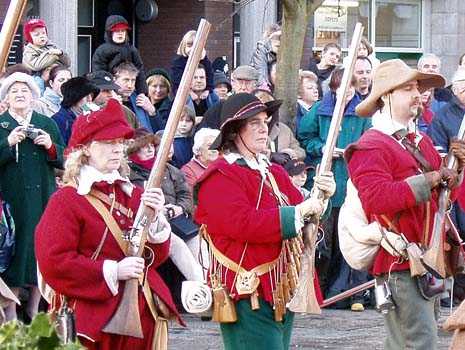 |
|
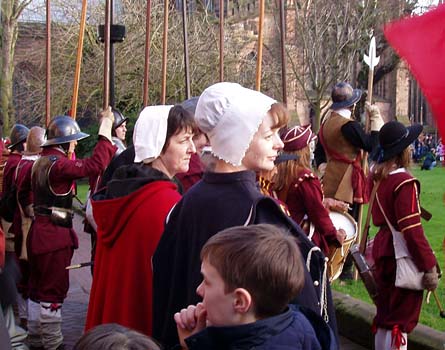 |
| All present and correct |
|
Camp followers |
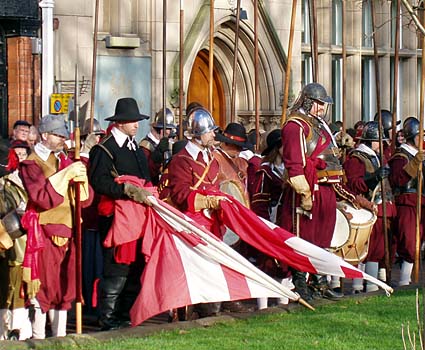 |
|
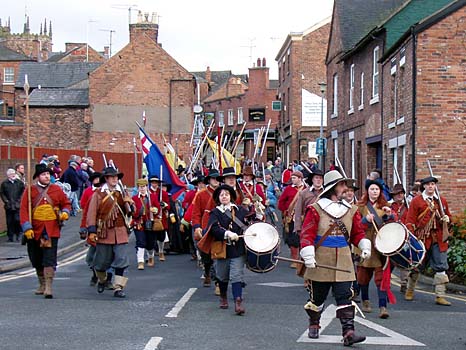 |
| Ceremony in the town centre |
|
Marching to the battlefield |
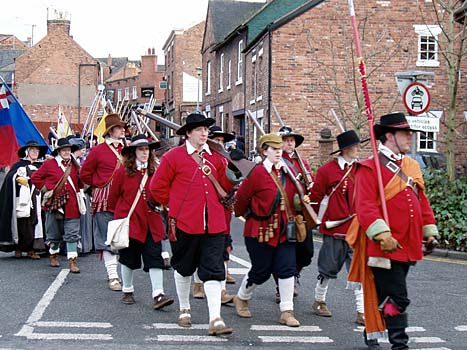 |
|
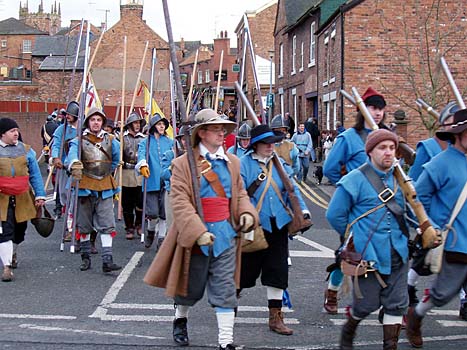 |
| Marching to the battlefield |
|
Marching to the battlefield |
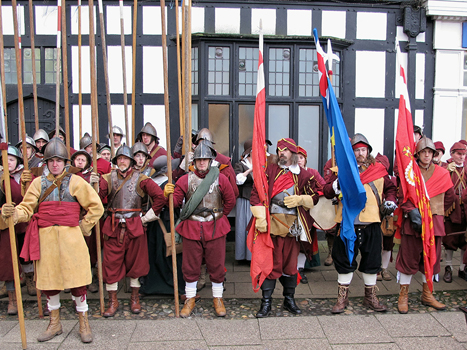 |
|
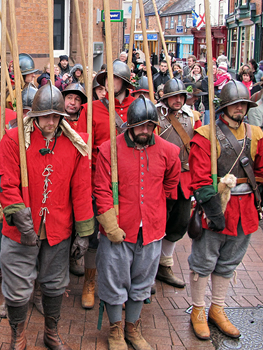 |
| Town Centre parade, 2012 |
|
Moment of silence, 2012 |
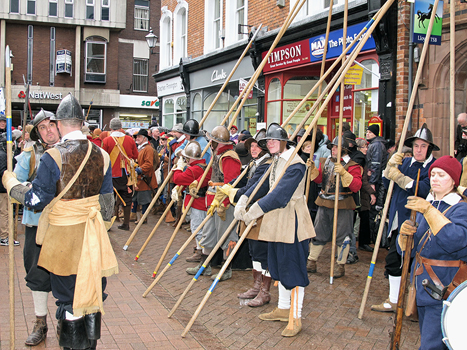 |
|
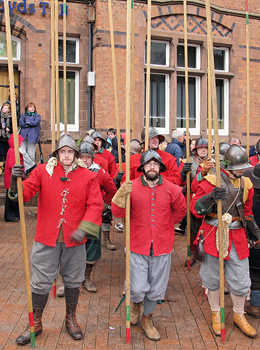 |
| On Parade, 2012 |
|
On Parade, 2012 |
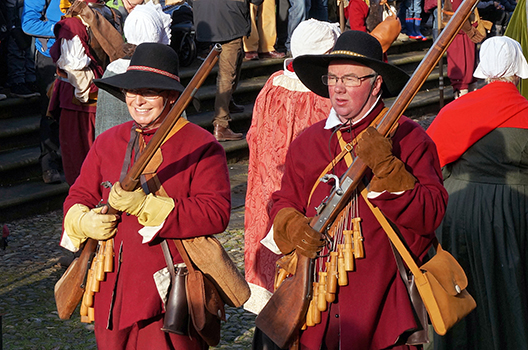 |
|
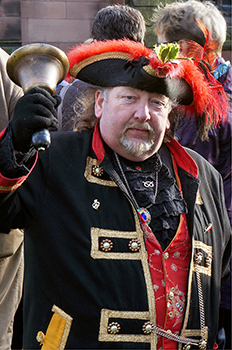 |
| Musketeers in 2014 |
|
Town Crier in 2014 |
The Battle of Nantwich in
the English Civil War
It is probably not commonly known that during the English Civil
War there were as many men engaged in military forces as a proportion of population
as there were in the Second World War. The population of England and Wales at
the time was about 6 million with about 1.5 million in Scotland. Nantwich had
a population of about 10,000 while that of Chester was possibly 25,000.
During 1643, King Charles could not assemble his whole army at
Oxford. There was an army in the west under Hopton, that of Lord Byron in Wales
and West Cheshire and the force in the North East which was countered by General
Fairfax's forces in Yorkshire. Charles hoped to get more troops from Ireland
via Chester and North Wales. If he could concentrate his forces at Oxford he
could march on London, held by the Parliamentarians.
Nantwich was a Parliamentary HQ and stood in the way of Byron reaching the
south from Chester. Parliament made an alliance with the Scottish Covenanters.
At this time England and Scotland were separate countries but had the same King.
The Covenanters thought that if Charles I won the war in England he would return
to his business of introducing the changes of Archbishop Laud that had led to
the Bishops' War. The Covenanters were strongly opposed to Laud's dilution of
Protestantism.
Nantwich turned out to be of strategic importance because of its position in
blocking Byron and this was perceived by General Fairfax. It was sufficiently
important to lead to a battle in the winter months which were unsuitable for
campaigning because of the poor state of the roads in winter. Beeston Castle had been
a Parliamentary outpost commanding the crossing through the Peckforton hills
but on 13 December 1643 the Royalists captured it. Steel, a former cheese merchant,
was in command and many thought that he surrendered too quickly. He was subsequently
tried by court martial and shot. The Royalists then advanced from Chester past
Beeston to threaten Nantwich. The cavalry was aided by the cold weather, which
had frozen otherwise boggy ground particularly to the south and west of Nantwich.
Nantwich is protected to the west by the River Weaver. To the south of the
town the river is much narrower as at this point several small tributaries come
together. The approach to Nantwich down Welsh Row leads to the bridge in front
of the town. In December, Royalist forces came south to the west of Nantwich
through Wrenbury and then turned east to Audlem and on to Barthomley. The Royalists
planned to encircle Nantwich. The garrison tried to break out to the east but
were driven back at Holmes Chapel. On the 28th December, the Royalists took
the village of Crewe and then approached closer to Nantwich to take Dorfold
Hall, the house of one of the Wilbrahams. From there they could shell Nantwich
with red hot shot in an attempt to burn the town. Nantwich had been destroyed
in the great fire of 1583 and this would have been in the folk memory of those
defending it. Everybody turned out to prevent the fires, led by Mrs. Brett a
washer woman. By the time of the Battle of Nantwich the market had not been
held for six weeks.
On the 12 January, forces from Nantwich had to sally forth to gather food. On
the 16th, Byron called on the town to surrender but it did not. On the 18th
a direct attack was made on the town from the West but stopped at the bridge.
The victor at Beeston was killed in Welsh Row.
Byron had put up a pontoon bridge to allow his men access to both sides of
the Weaver south of the town. He needed to maintain forces to the west to secure
his supply lines from Chester and his line of retreat. On the other hand the
east side of the town was easier to attack and he needed to prevent reinforcements
from that side. As a result his forces were divided by the river. At this point
two important events took place. The Royalists were running short of ammunition
but supplies coming to them from the south were intercepted by Parliamentarians
at Wem in Shropshire. The second event was a major thaw resulting in the ground
becoming soggy south of Nantwich and the river rising so that the pontoon bridge
was abandoned. Byron's forces were now divided with a long journey south
of Nantwich required to cross the Weaver.
Meanwhile, Fairfax, perceiving the danger that would ensue if Nantwich fell,
crossed the Pennines from Lincolnshire, and gathered forces in Lancashire that
were investing the Earl of Derby's house at Lathom. He crossed the Mersey and
collected Parliamentary troops from Manchester and East Cheshire, gathering
them at Delamere. They moved south towards Nantwich and came into contact with
Royalist forces at Acton. The Royalists had about 1,000 cavalry and 2,500 infantry
whereas the Parliamentarians had 1,800 cavalry, 500 dragoons and 2,500-3,000
infantry
Forces from Nantwich sallied forth to attack the Royalists
from behind. The country was unsuitable for cavalry because of the small enclosed
fields and Byron made his way back to Chester. About 200 Royalists were killed
and 1,500 infantry surrendered. They were made prisoners in the church at Nantwich.
Most of the Royalist artillery was captured. There were few casualties on the
Parliamentary side.
After the Battle of Nantwich, Prince Maurice was sent to Chester to organise
the defences. Beeston Castle was not retaken by the Parliamentarians until 1645.
In the first week of December that year Lathom Hall surrendered and Colonel
John Booth was able to bring troops south to Beeston where food supplies were
exhausted. With the fall of Beeston its beseigers could reinforce those at Chester
and cut the remaining lines of communication for the Royalists there. No rescuing
force came from Oxford and eventually Lord Byron, the Royalist commander, was
forced to negotiate surrender with General Brereton,
who occupied the town on 3 February. For the first time in three years, there
was no fighting in Cheshire.
(Note that at this period the Julian Calendar was still in
use in England. The year began on 25 March. Thus December 1644 was followed
by January 1644. The Gregorian Calendar, in which the year begins on 1 January
was not introduced in England until 1752. However, many authors writing about
this period change the dates as if the Gregorian Calendar had been introduced
already. Thus the Battle or Nantwich took place in January 1643 on the Julian
Calendar but January 1644 on the Gregorian Calendar.)
Sources:
The Sealed Knot
Sir William
Brereton
The Civil War in Cheshire, by R.N. Dore, Volume 8 of a History of Cheshire, general editor J. J. Bagley, published by Cheshire Community Council, Chester, 1966.
Notes taken on The English Civil War in Lancashire and Cheshire, a course of lectures at Wilmslow Guild by Clare Pye, Autumn 2002.
I am grateful to John Brough for pointing out to me that the correct name of the festival as Holly Holy Day not Holiday (and declaring me an Honorary Dabber for my website)
Nantwich Page 1: The Church of St. Mary
Nantwich Page 3: Town Centre















